Introduction
In the vast culinary landscape of China, traditional dishes often carry a rich history and cultural significance, passed down through generations. Among these, preserved pork, or “la rou” in Mandarin, stands out as a staple in many households, especially during the colder months. Its unique flavor, a blend of saltiness, sweetness, and a hint of smoke, pairs wonderfully with a variety of vegetables. One such delightful combination is preserved pork stir-fried with garlic sprouts, a dish that balances the savory richness of the meat with the fresh, slightly spicy notes of the garlic sprouts.
This article aims to guide you through the entire process, from preparing the preserved pork to stir-frying it with garlic sprouts, ensuring you capture the essence of this classic Chinese dish. Whether you’re a seasoned chef or a home cook eager to explore new culinary territories, this guide will provide you with the knowledge and techniques needed to create a memorable meal.
Section 1: Understanding Preserved Pork
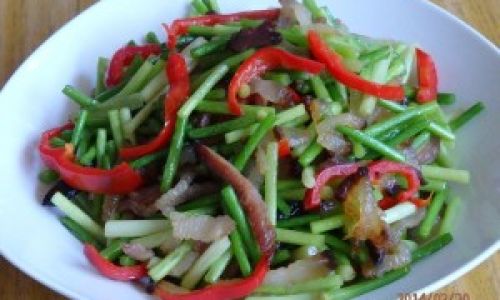
1 What is Preserved Pork?
Preserved pork, also known as “la rou,” is a type of preserved meat that has been salted, seasoned, and often smoked or air-dried to extend its shelf life. It originated as a way to preserve meat during times when refrigeration was not available, but it has evolved into a culinary delight appreciated for its flavor and texture.
2 Types of Preserved Pork
There are several varieties of preserved pork, each with its unique characteristics:
- Bacon: Typically thinly sliced and often smoked, bacon is widely used in Western cuisine but also finds its place in Chinese dishes.
- Ham: Salted and sometimes smoked, ham is usually cooked before eating and is great for sandwiches or slicing thinly for stir-fries.
- Chinese Sausage (Lap Cheong): Made from pork mixed with sugar, salt, rice wine, and other spices, and then hung to dry, Chinese sausage is sweet, salty, and slightly chewy.
- Preserved Pork Belly (Lou Rou): Specifically refers to pork belly that has been salted, seasoned, and dried. It is often steamed or used in stir-fries and soups.
For this recipe, we will focus on preserved pork belly, as it provides the perfect balance of fat and lean, adding a rich, moist flavor to the dish.
3 Preparing Preserved Pork
Before using preserved pork, it often needs to be soaked and cooked to remove excess salt and to soften the meat. Here’s how:
- Soaking: Place the preserved pork in a bowl of cold water and soak for several hours or overnight, changing the water a few times to remove excess salt.
- Boiling: After soaking, boil the pork in fresh water for about 30 minutes to an hour, depending on its thickness. This step further reduces the saltiness and ensures the meat is tender.
- Cooling and Slicing: Once cooked, let the pork cool slightly before slicing it into thin strips or pieces, ready for stir-frying.
Section 2: Introducing Garlic Sprouts
1 What Are Garlic Sprouts?
Garlic sprouts, also known as garlic chives or Chinese chives, are a type of vegetable with a mild garlic flavor and a tender, slightly crisp texture. They are a staple in Chinese cuisine, often used in stir-fries, soups, and dumplings.

2 Selecting Garlic Sprouts
When choosing garlic sprouts, look for bright green stalks with firm, fresh-looking leaves. Avoid those that are wilted, yellowing, or have spots. The stems should snap easily when bent, indicating freshness.
3 Preparing Garlic Sprouts
- Rinsing: Wash the garlic sprouts thoroughly under running water to remove any dirt or debris.
- Trimming: Cut off the root ends and any wilted or discolored parts.
- Cutting: Depending on the recipe, you may want to cut the garlic sprouts into shorter lengths for easier stir-frying.
Section 3: Making Preserved Pork Stir-Fried with Garlic Sprouts
1 Ingredients
- Preserved Pork: 200g (prepared as described above)
- Garlic Sprouts: 300g (prepared as described above)
- Garlic: 3 cloves, minced
- Ginger: 1 tablespoon, minced
- Oyster Sauce: 1 tablespoon
- Soy Sauce: 1 tablespoon (light or dark, to taste)
- Shaoxing Wine (or dry sherry): 1 tablespoon
- Sugar: 1/2 teaspoon (optional, to balance flavors)
- Salt: To taste (note that preserved pork is already salty, so use sparingly)
- Vegetable Oil: 2 tablespoons
- Red Pepper Flakes (optional): 1/2 teaspoon for a bit of heat
- Cornstarch Slurry (optional): 1 tablespoon cornstarch mixed with 2 tablespoons water for thickening the sauce
- Sesame Oil (optional): A few drops for garnish
- Green Onions (optional): Chopped for garnish
2 Equipment
- Wok or large skillet
- Wooden spoon or spatula for stirring
- Measuring spoons and cups
- Knife and cutting board
- Mixing bowls
3 Instructions
Step 1: Heat the Wok
Place your wok or large skillet over medium-high heat and add the vegetable oil. Allow the oil to heat up until it shimmers but not smokes.
Step 2: Aromatics
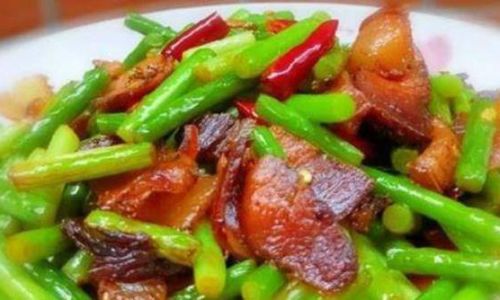
Add the minced garlic and ginger to the hot oil. Stir-fry for about 30 seconds until fragrant but not burnt. If using red pepper flakes, add them now to release their heat.
Step 3: Preserved Pork
Add the prepared slices of preserved pork to the wok. Stir-fry for about 2-3 minutes, until the edges start to brown and the fat renders out, adding flavor to the oil.
Step 4: Seasonings
Pour in the Shaoxing wine (or dry sherry), followed by the oyster sauce, soy sauce, and sugar (if using). Stir well to coat the pork with the seasonings and cook for another minute, allowing the alcohol to evaporate and the flavors to meld.
Step 5: Garlic Sprouts
Add the prepared garlic sprouts to the wok, stirring gently to combine with the pork and seasonings. Stir-fry for about 2-3 minutes, until the sprouts are tender-crisp and bright green.
Step 6: Thickening (Optional)
If you prefer a thicker sauce, add the cornstarch slurry to the wok and stir quickly to combine. The sauce should thicken within a minute.
Step 7: Taste and Adjust
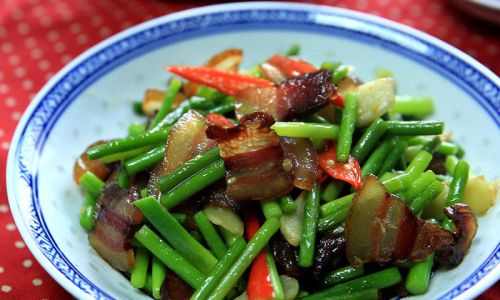
Taste the dish and adjust the seasoning with additional soy sauce or salt if needed. Remember that preserved pork is already salty, so be cautious with additional salt.
Step 8: Garnish and Serve
Drizzle a few drops of sesame oil over the dish for added flavor and garnish with chopped green onions if desired. Serve immediately with steamed rice or your favorite side dish.
Section 4: Tips and Variations
1 Tips for Perfect Stir-Frying
- High Heat: Stir-frying requires high heat to sear the ingredients and lock in flavors. Make sure your wok or skillet is hot before adding oil.
- Stir Constantly: To avoid burning, stir the ingredients frequently and evenly.
- Don’t Crowd the Pan: Overloading the pan will reduce the heat and steam the ingredients rather than stir-fry them.
2 Variations
- Vegetarian Version: Replace the preserved pork with tofu or tempeh, marinated in a mixture of soy sauce, sugar, and Shaoxing wine before stir-frying.
- Additional Vegetables: Add bell peppers, mushrooms, or baby corn for added texture and nutrition.
- Spicy Kick: Increase the heat by adding sliced fresh chili peppers or more red pepper flakes.
- Sauce Variations: Experiment with different sauces like hoisin, chili sauce, or black bean sauce to create unique flavors.
Conclusion
Preserved pork stir-fried with garlic sprouts is a dish that embodies the essence of Chinese home cooking: simple ingredients, bold flavors, and a balance of textures. By following the steps outlined in this article, you can recreate this classic dish in your own kitchen, bringing a touch of traditional Chinese cuisine to your table. Whether you’re celebrating a special occasion or just enjoying a quiet evening at home, this dish is sure to delight your taste buds and warm your heart.
Remember, cooking is an art that requires practice and patience. Don’t be afraid to experiment with different ingredients and techniques to make the dish your own. With each attempt, you’ll gain

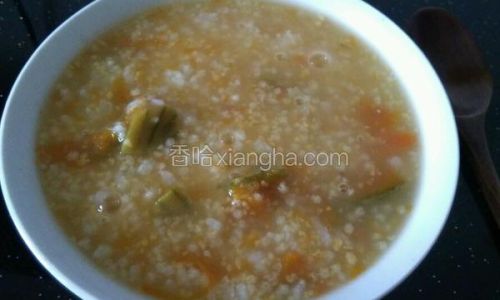
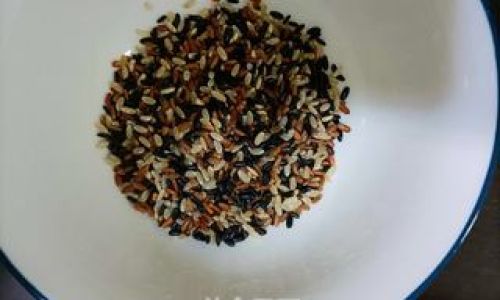
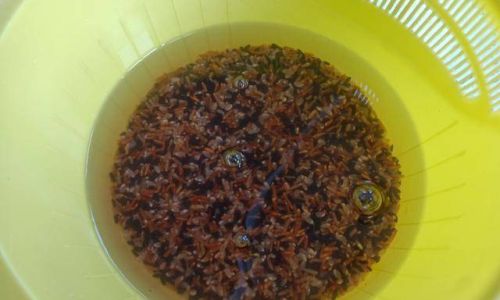

0 comments